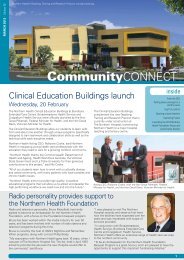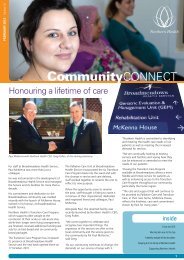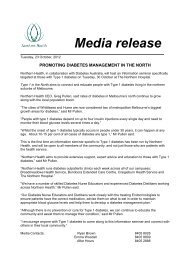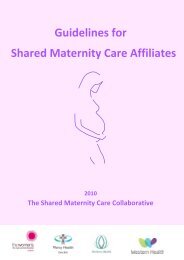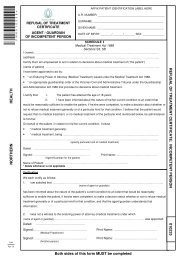Research Week Abstract Book - Northern Health
Research Week Abstract Book - Northern Health
Research Week Abstract Book - Northern Health
You also want an ePaper? Increase the reach of your titles
YUMPU automatically turns print PDFs into web optimized ePapers that Google loves.
Haematology<br />
HaematOLOGY<br />
Intermittent Granulocyte-Colony Stimulating FaCTor (G-Csf)<br />
Maintains Dose Intensity After ABVD Therapy Complicated By<br />
Neutropenia<br />
Ho P, Sherman P and Grigg A.<br />
Background<br />
G-CSF is commonly used to maintain dose-intensity in patients receiving ABVD for Hodgkin lymphoma (HL). However,<br />
some studies suggest that dose-intensity can be maintained without G-CSF, with minimal incidence of febrile neutropenia.<br />
Moreover, G-CSF is expensive (approximately A$1925 for pegfilgrastim and A$1050 for 7 days of 300ug filgrastim per cycle)<br />
and is associated with side-effects including bone pain and increased risk of bleomycin-related lung toxicity. Intermittent<br />
G-CSF may be an effective compromise, given that G-CSF effect on granulocyte precursors in-vitro persists for 4-5 days<br />
after administration and intermittent scheduling is effective in maintaining dose-intensity in breast cancer patients receiving<br />
adjuvant chemotherapy. After a promising pilot study using intermittent G-CSF for ABVD complicated by neutropenia, this<br />
schedule has been used at physician discretion at RMH.<br />
Aim<br />
To compare the efficacy of daily/pegylated versus intermittent G-CSF protocols between 1996 and 2009.<br />
Method<br />
Retrospective analysis of the incidence of neutropenia, treatment delays and febrile neutropenia in patients receiving different<br />
G-CSF schedules.<br />
Results<br />
848 cycles in 85 patients (M:F 43:42; median age = 32 (range:14-71) years) with predominantly stage II/III HL were<br />
evaluated. The median neutrophil count when cycle 1B was due was 0.9 (range:0-18.7). Most patients(86%) received<br />
G-CSF, generally commencing during cycle 1B. Intermittent G-CSF (typically given on days 4,8,12) was used in 452 cycles<br />
compared with 99 cycles for daily/pegylated G-CSF. Febrile neutropenia occurred in 2 and 0 cycles respectively and no<br />
treatment delays due to neutropenia occurred in either group. After intermittent G-CSF, the median neutrophil count was 7.3<br />
(range:1.4-47.1x10 9 /L) when chemotherapy was next due, similar to other G-CSF regimens. The cost difference between<br />
pegfilgrastim and three doses of 300ug filgrastim per cycle over 11 cycles ( i.e. cycles 1B-6B ) was A$16500.<br />
Conclusion<br />
Intermittent G-CSF is effective in maintaining dose-intensity in patients receiving ABVD, resulting in substantial cost savings.<br />
31



